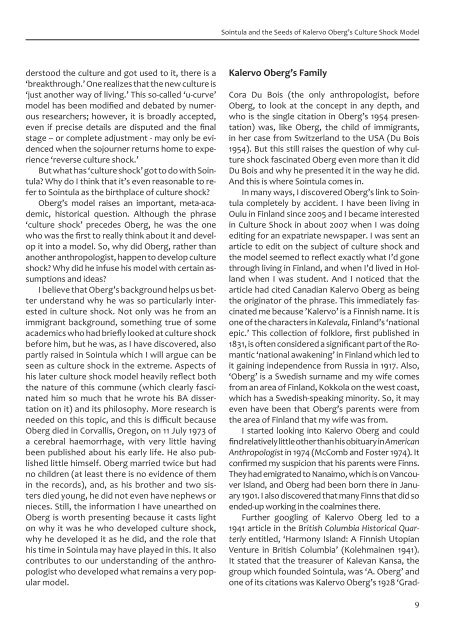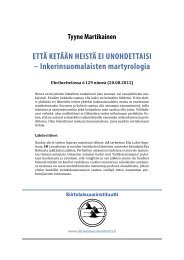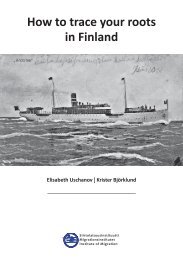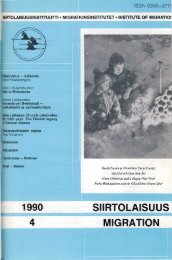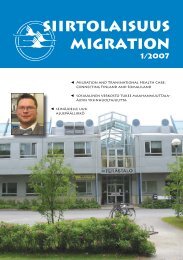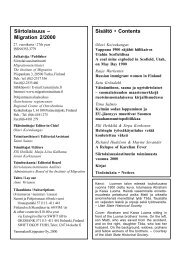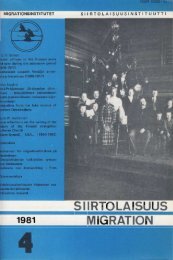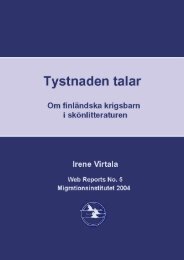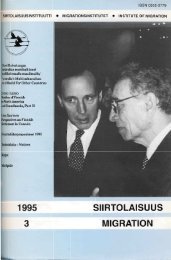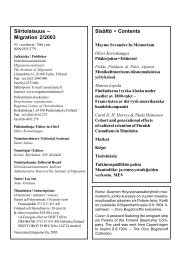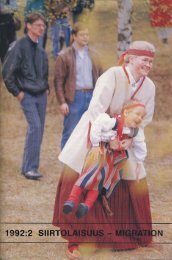Siirtolaisuus-Migration 4/2013 - Siirtolaisuusinstituutti
Siirtolaisuus-Migration 4/2013 - Siirtolaisuusinstituutti
Siirtolaisuus-Migration 4/2013 - Siirtolaisuusinstituutti
Create successful ePaper yourself
Turn your PDF publications into a flip-book with our unique Google optimized e-Paper software.
Sointula and the Seeds of Kalervo Oberg’s Culture Shock Modelderstood the culture and got used to it, there is a‘breakthrough.’ One realizes that the new culture is‘just another way of living.’ This so-called ‘u-curve’model has been modified and debated by numerousresearchers; however, it is broadly accepted,even if precise details are disputed and the finalstage – or complete adjustment - may only be evidencedwhen the sojourner returns home to experience‘reverse culture shock.’But what has ‘culture shock’ got to do with Sointula?Why do I think that it’s even reasonable to referto Sointula as the birthplace of culture shock?Oberg’s model raises an important, meta-academic,historical question. Although the phrase‘culture shock’ precedes Oberg, he was the onewho was the first to really think about it and developit into a model. So, why did Oberg, rather thananother anthropologist, happen to develop cultureshock? Why did he infuse his model with certain assumptionsand ideas?I believe that Oberg’s background helps us betterunderstand why he was so particularly interestedin culture shock. Not only was he from animmigrant background, something true of someacademics who had briefly looked at culture shockbefore him, but he was, as I have discovered, alsopartly raised in Sointula which I will argue can beseen as culture shock in the extreme. Aspects ofhis later culture shock model heavily reflect boththe nature of this commune (which clearly fascinatedhim so much that he wrote his BA dissertationon it) and its philosophy. More research isneeded on this topic, and this is difficult becauseOberg died in Corvallis, Oregon, on 11 July 1973 ofa cerebral haemorrhage, with very little havingbeen published about his early life. He also publishedlittle himself. Oberg married twice but hadno children (at least there is no evidence of themin the records), and, as his brother and two sistersdied young, he did not even have nephews ornieces. Still, the information I have unearthed onOberg is worth presenting because it casts lighton why it was he who developed culture shock,why he developed it as he did, and the role thathis time in Sointula may have played in this. It alsocontributes to our understanding of the anthropologistwho developed what remains a very popularmodel.Kalervo Oberg’s FamilyCora Du Bois (the only anthropologist, beforeOberg, to look at the concept in any depth, andwho is the single citation in Oberg’s 1954 presentation)was, like Oberg, the child of immigrants,in her case from Switzerland to the USA (Du Bois1954). But this still raises the question of why cultureshock fascinated Oberg even more than it didDu Bois and why he presented it in the way he did.And this is where Sointula comes in.In many ways, I discovered Oberg’s link to Sointulacompletely by accident. I have been living inOulu in Finland since 2005 and I became interestedin Culture Shock in about 2007 when I was doingediting for an expatriate newspaper. I was sent anarticle to edit on the subject of culture shock andthe model seemed to reflect exactly what I’d gonethrough living in Finland, and when I’d lived in Hollandwhen I was student. And I noticed that thearticle had cited Canadian Kalervo Oberg as beingthe originator of the phrase. This immediately fascinatedme because ’Kalervo’ is a Finnish name. It isone of the characters in Kalevala, Finland’s ‘nationalepic.’ This collection of folklore, first published in1831, is often considered a significant part of the Romantic‘national awakening’ in Finland which led toit gaining independence from Russia in 1917. Also,‘Oberg’ is a Swedish surname and my wife comesfrom an area of Finland, Kokkola on the west coast,which has a Swedish-speaking minority. So, it mayeven have been that Oberg’s parents were fromthe area of Finland that my wife was from.I started looking into Kalervo Oberg and couldfind relatively little other than his obituary in AmericanAnthropologist in 1974 (McComb and Foster 1974). Itconfirmed my suspicion that his parents were Finns.They had emigrated to Nanaimo, which is on VancouverIsland, and Oberg had been born there in January1901. I also discovered that many Finns that did soended-up working in the coalmines there.Further googling of Kalervo Oberg led to a1941 article in the British Columbia Historical Quarterlyentitled, ‘Harmony Island: A Finnish UtopianVenture in British Columbia’ (Kolehmainen 1941).It stated that the treasurer of Kalevan Kansa, thegroup which founded Sointula, was ‘A. Oberg’ andone of its citations was Kalervo Oberg’s 1928 ‘Grad-9


